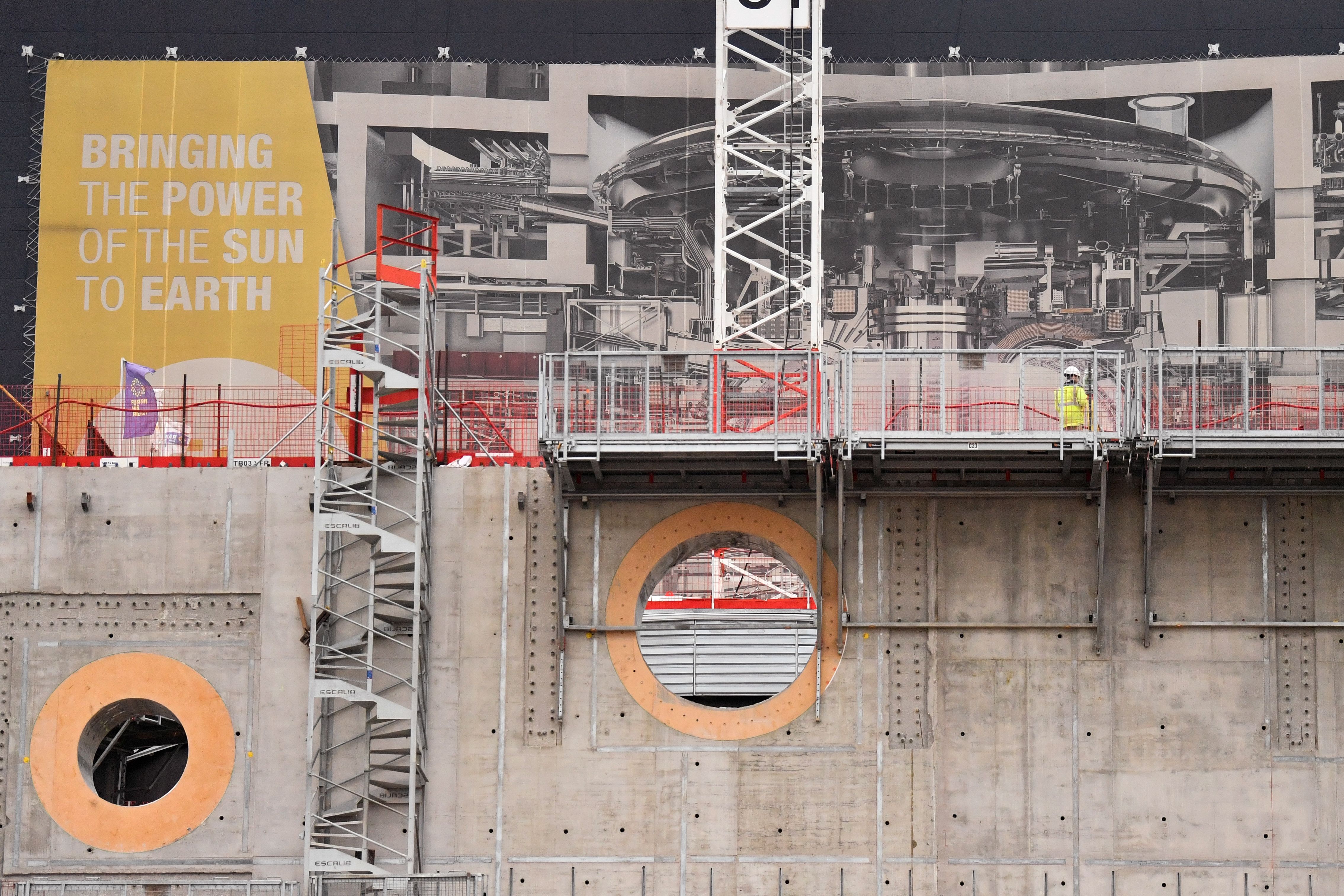Is nuclear fusion the answer?
The race is on to build fusion reactors that would provide limitless energy without nuclear waste or carbon emissions


U.S. researchers have successfully produced a nuclear fusion reaction that created a net energy gain for the first time ever. The breakthrough, initially reported by the Financial Times, marks a major milestone in the decades-long efforts to provide limitless energy without nuclear waste or carbon emissions. Here's everything you need to know:
What is fusion?
Thermonuclear fusion is the nuclear reaction that powers the sun and all stars. It occurs when two nuclei of a lightweight element such as hydrogen collide at colossal speed, forcing them to fuse. Leftover mass is converted into enormous amounts of energy, according to Einstein's formula E = mc2. Unlike fission, in which atoms are split, fusion requires small amounts of ordinary fuel — the amount of hydrogen in a glass of water could provide enough energy for one person's lifetime — and does not create much radioactive waste, which is why it's been called "the holy grail for the future of nuclear power." Proponents believe fusion reactors could solve the climate-change crisis by providing inexhaustible energy with zero emissions and no chance of a meltdown. But the challenge of creating fusion reactions is enormous: Scientists and engineers essentially have to create a small star. Hydrogen must be heated to about 100 million degrees Celsius — six times hotter than the sun's core. At that temperature, hydrogen is no longer a gas but a plasma, a soupy mix of charged particles that is incredibly difficult to sustain. Scientists have been trying to contain the plasma using a tokamak, a doughnut-shaped structure with an extremely strong magnetic field, but thus far have been successful only for seconds.
Why attempt such a feat?
With the climate crisis intensifying, President Biden has pledged to eliminate all greenhouse-gas emissions from the electricity sector by 2035. Solar, wind, and hydropower will play a major role, but those technologies aren't feasible everywhere, so Biden's energy plan also includes nuclear technologies. One option is to build mini-fission reactors that would be much safer and cheaper to produce than the current generation of aging nuclear plants. But nuclear fusion would be far superior, as it avoids the vast piles of radioactive waste that must be stored for thousands of years. Governments around the world are pouring billions into the research, as are private investment ventures such as Breakthrough Energy Ventures, started by Microsoft founder Bill Gates.
The Week
Escape your echo chamber. Get the facts behind the news, plus analysis from multiple perspectives.

Sign up for The Week's Free Newsletters
From our morning news briefing to a weekly Good News Newsletter, get the best of The Week delivered directly to your inbox.
From our morning news briefing to a weekly Good News Newsletter, get the best of The Week delivered directly to your inbox.
One of the biggest projects is ITER, a tokamak the size of 60 soccer fields that is under construction in France and is expected to operate in 2035. ITER, which means "the way" in Latin and originally stood for International Thermonuclear Experimental Reactor, is a joint effort of the European Union, U.S., U.K., China, Russia, Japan, India, and South Korea. Preliminary experiments are being done at a mock-up facility in Britain. But several retired fusion physicists, including Ernesto Mazzucato and Daniel Jassby of Princeton's Plasma Physics Lab, have described ITER as a boondoggle run by bureaucrats that is likely to waste its potential cost of up to $65 billion.
What's the latest research?
The quest to harness nuclear fusion has seen recent leaps forward. In February, U.K. scientists announced they were able to generate and sustain nuclear fusion at more than double the rate of the previous record. U.S. Energy Secretary Jennifer Granholm likewise announced a major scientific breakthrough in nuclear fusion research on Dec. 13; she confirmed that scientists at California's National Ignition Facility at the Lawrence Livermore National Laboratory were able to create a nuclear fusion reaction that resulted in a net energy gain of 1.5 megajoules. Dr. Robbie Scott, of the Science and Technology Facilities Council, was involved in the research and called the development "a huge breakthrough" for "laser fusion research."
During a press conference at the Department of Energy's headquarters, White House science adviser Arati Prabhakar said, "This is such a wonderful example of a possibility realized, a scientific milestone achieved, and a road ahead to the possibilities for clean energy."
So is climate change solved?
Not yet. While the latest developments are promising, experts say we are still decades away from commercial use. Still, there's reason to feel hopeful: Kimberly S. Budil, the director of Lawrence Livermore, doesn't think it will take as long to achieve nuclear fusion as previously believed. "Not six decades, I don't think," she estimated to reporters. "I think not five decades, which is what we used to say. I think it's moving into the foreground and probably, with concerted effort and investment, a few decades of research on the underlying technologies could put us in a position to build a power plant."
A free daily email with the biggest news stories of the day – and the best features from TheWeek.com
Still, other experts believe the milestone is more symbolic than groundbreaking. Charles Seife, author of Sun in a Bottle: The Strange History of Fusion and the Science of Wishful Thinking, writes for The Atlantic that "the work doesn't address any of the myriad other scientific, technical, and design problems that would need to be solved before we really can take off from the ground and claim that we've produced more energy with fusion than we've consumed."
There have been other significant technological breakthroughs in the field. Materials are now available that can withstand or prevent erosion of the container around the plasma, including reduced-activation steel and tungsten. And high-temperature superconducting magnets have been developed that can create vastly stronger magnetic fields and can be kept cool by cheap and abundant liquid nitrogen instead of rare liquid helium. That means fusion reactors much smaller than ITER can be developed.
Who is working on those?
One company, Commonwealth Fusion Systems, spun out of MIT in 2017, has some $250 million in private capital backing and is building a tokamak the size of a tennis court that will cost a fraction of ITER. It plans to bring a prototype reactor online by 2025 that can generate about 270 megawatts, enough to power 100,000 homes. A British company, First Light Fusion, is using an entirely different method of confining plasma, inspired by a crustacean called the pistol shrimp. When this shrimp snaps its claw to stun prey, it creates bubbles that collapse so forcefully that the vapor inside briefly turns to plasma at 4,700 degrees Celsius. This mini-explosion creates so much noise that pistol shrimp colonies interfere with submarine sonar. Using a similar technique, First Light hopes to demonstrate net energy gain by 2024.
An alternative: Small fission reactors
Cutting-edge energy firms — including Bill Gates' TerraPower — are working on mini–fission reactors known as small modular reactors, or SMRs. In 2020, the Nuclear Regulatory Commission gave its first approval to such a device, greenlighting a design by Oregon company NuScale Power that would generate 50 megawatts of electricity. That's much less than the 1,000 MW of a traditional reactor, but utilities could link up to 12 together to power a medium-size city. Some SMR companies are using molten salt as a coolant rather than water, with no pumps and valves that can break; proponents say such a reactor can't melt down, so no large evacuation zone is required. Critics, though, point out that even small fission reactors cost billions to build, and they still produce radioactive waste that must be stored somewhere at great cost and risk. "Although SMRs have lower upfront capital cost per unit," says the International Atomic Energy Agency, "their economic competitiveness is still to be proven."
This article was first published in The Week magazine in 2021 and was updated on Dec. 13, 2022, to reflect the latest breakthroughs. If you want to read more articles like it, you can try six risk-free issues of the magazine here.
-
 The curious history of hanging coffins
The curious history of hanging coffinsUnder The Radar Ancient societies in southern China pegged coffins into high cliffsides in burial ritual linked to good fortune
-
 The Trump administration says it deports dangerous criminals. ICE data tells a different story.
The Trump administration says it deports dangerous criminals. ICE data tells a different story.IN THE SPOTLIGHT Arrest data points to an inconvenient truth for the White House’s ongoing deportation agenda
-
 Ex-FBI agents sue Patel over protest firing
Ex-FBI agents sue Patel over protest firingspeed read The former FBI agents were fired for kneeling during a 2020 racial justice protest for ‘apolitical tactical reasons’